
|
| To manage your topical and publication subscriptions, visit the My Account area of the PSC website. Once logged in, click Edit Profile, and then the Committees & Preferences tab, where you will find a host of topic areas, committees, task forces, and publications. It's as easy as clicking the boxes to make sure you are always up to date with relevant information. |
Sequestration Preparation
As part of PSC’s commitment to keep you informed of significant policy issues relating to the risk of sequestration, below are important updates.
Quick Jump Links:
2/27/13 - OMB Issues Sequestration Implementation Guidance
On February 27, OMB Controller Danny Werfel issued a memo to executive departments and agencies on “Agency Responsibilities for Implementation of Potential Joint Committee Sequestration.” The memo builds upon the January 14 guidance from Acting OMB Director Jeff Zients, and encourages agencies to communicate with stakeholders, including contractors, of the expected impact of sequestration on their operations. With respect to acquisition, the memo states that sequestration will “require agencies to reduce contracting costs where appropriate” including “de-scoping or terminating for convenience…where no other options exists to reduce contracting costs.” Agencies are directed to “appropriately inform and negotiate with contractors [and] take all appropriate steps to minimize the impact on small businesses.” While the OMB memo provides general guidance, specific agency plans (with the exception of DoD) remain unclear.
2/25/13 - White House Details Cuts to all 50 States and D.C.
The White House on February 24th detailed how deep spending cuts set to begin March 1st would affect programs in every state and the District of Columbia.
The 51 fact sheets describe what would happen over the next seven months if it goes into effect.
2/22/13 – DPAP Memo
On February 21, Defense Procurement and Acquisition Policy (DPAP) Director Dick Ginman issued a memo rescinding the class deviation on “Providing Accelerated Payment to Small Business Subcontractors.” The memo notes that “DoD has discontinued the temporary practice of providing accelerated payments to all prime contractors [but] plans to continue … to assist small business prime contractors by paying them as quickly as possible…” While not expressly tied to sequestration, the recission of the class deviation is clearly an attempt to “normalize” DoD’s payment practices and could potentially signal similar changes at other agencies.
2/21/13 - DoD Memo on Communications with Media and Academia
DoD Under Secretary of Defense Frank Kendall issued to memorandum to the department’s leadership urging them to “keep industry informed about our plans and involved in our decision-making process to the maximum extent possible, particularly when ongoing or upcoming contracts may be affected” by sequestration. Acquisition and program officials are “authorized and encouraged to have discussions with industry as they finalize plans relative to potential sequestration impacts and continuing resolution impacts,” he said. “[E]ngaging in this dialogue will allow industry to more productively make their own internal business plans to deal with potential sequestration impacts,” according to the Kendall memo.
2/21/13 - Principal Deputy Assistant Secretary of Defense for Readiness and Force Management memo on "Total Force Management and Budgetary Uncertainty"
DoD's principal deputy assistant secretary of defense for Readiness and Force Management issued a memo providing reminders to DoD about the authorities and restrictions on total force management under budget austerity. The memo highlights the importance of reviewing contracted services "to ensure the most appropriate, cost effective, and efficient suppport aligned to missions." It reminds readers that work cannot be converted from public sector to private sector performance without conducting a public-private competition, but that such competitions are prohibited! It also provides a reminder that the restrictions on contract support spending imposed by Section 808 of the Fiscal Year 2012 National Defense Authorization Act remains in effect for fiscal year 2013.
2/19/13 - Navy Sequestration Website
As the Navy considers options to deal with a potential $4-$9 billion shortfall in operating and maintenance accounts, the Navy has provided a website that it should be regularly updating with background information on the Continuing Resolution and sequestration; the website is available here.
2/11/13 – PSC Challenges Union Claims on Sequestration
In response to a federal employee union report asserting that the government can—and should—achieve up to 90 percent of required sequestration savings by cutting contracts, PSC issued a media statement refuting these claims and drawing attention to the negative consequences that contractors have already faced as a result of contract cuts over the past several years, and the potentially disastrous outcomes that could result from additional cuts of the magnitude suggested. PSC countered that arbitrary cuts to either federal employees or contractors are equally misguided strategies, and that the two sides should work together to fight the common enemy of sequestration.
2/4/13 - Congressional Research Service Report
On February 4, the Congressional Research Service issued a short report on the modifications to the budget enforcement procedures under the 2011 Budget Control Act that were made by the American Taxpayer Relief Act of 2012 (P.L. 112-240 Jan 2, 2013).
1/31/13 - PSC Releases White Paper on Austerity Impacts on Services Contractors
In recent weeks, some federal employee organizations have called on Congress to mandate substantial reductions in the use of contractors in lieu of furloughs for federal employees, claiming that contractors will otherwise be largely immune from the realities of austerity. In response, PSC has created this white paper highlighting the very real effects of budget austerity, effects that services contractors are already feeling, and calling for the government to focus on the bigger picture of how to best execute their missions in a time of unprecedented budget uncertainty.
PSC White Paper: The (Workforce) Realities of Austerity
1/24/13 - OMB Releases PAYGO Report
Today OMB released a required annual PAYGO report, including a sequestration order if necessary, no later than 14 working days after the end of a congressional session. This Report describes the budgetary effects of all legislation enacted during the second session of the 112th Congress and presents the 5-year and 10-year PAYGO scorecards maintained by OMB. Because neither the 5-year nor 10-year scorecard shows a debit for the budget year, which for purposes of this Report is fiscal year 2013, a sequestration order under subsection 5(b) of the PAYGO Act, 2 U.S.C §934(b), is not necessary.
The full text of the OMB report is available here.
Fiscal Year 2013 Sequestration Guidance
Following the enactment of the American Taxpayer Relief Act of 2012 (ATRA) on January 2, 2013, a number of government departments, agencies, and commands—mostly within the Department of Defense—began issuing broad guidance in preparation for the possibility of across-the-board sequestration on March 1 and the expiration of the Continuing Resolution on March 27, among other events. PSC has collected agency guidance documents below.
Executive Office of the President
2/27/13 – OMB Controller Danny Werfel Memo on
“Agency Responsibilities for Implementation of Potential Joint Committee Sequestration”
2/25/13 - The White House on February 24th detailed how deep spending cuts set to begin March 1st would affect programs in every state and the District of Columbia. The 51 fact sheets describe what would happen over the next seven months if it goes into effect.
2/8/13 - White House fact sheet on the potential impact of the March 1 sequester
According to the White House, non-defense agencies would have to absorb a 9 percent cut for the remaining seven months of the federal fiscal year while the Defense Department would see a 13 percent cut.
1/14/13 - OMB Director Jeff Zients Memo on
"Planning for Uncertainty with Respect to Fiscal Year 2013 Budgetary Resources"
Congress
2/13/13 - The Democratic members of the House Appropriations Committee
released a 38-page report detailing the scope of the funding and personnel cuts that would result from sequester and the impacts for a wide range of agencies, services and states
Civilian Agencies
2/21/13 – USAID Administrator Rajiv Shah Memo on “FY 2013 Sequestration Plan for USAID Employees”
2/20/13 – Department of Labor Acting Secretary Harris Memo on “The Impact of Sequestration.”
2/14/13 - In response to a January 18 request from Senate Appropriations Committee Chair Senator Barbara Mikulski, 20 federal agencies submitted letters to the Committee detailing the expected impact of March 1 sequestration on their operations
2/14/13 - NASA Letter on "Impacts of March 1, 2013 Sequester on FY 2013 President's Budget Request for NASA"
2/13/13 – Letter from DHS Secretary Janet Napolitano to House Homeland Security Committee Ranking Member Bennie Thompson on DHS Impacts of Sequestration
2/11/13 – USAID Administrator Rajiv Shah Memo on
“Preparations for Potential Sequestration on March 1”
2/7/13 – EPA Deputy Administrator Bob Perciasepe Memo on
"Preparations for Potential Sequestration on March 1"
2/6/13 – Department of Energy Deputy Secretary Daniel Poneman Memo on
“Preparations for Potential Sequestration on March 1”
2/5/13 – Department of Interior Deputy Secretary Memo on
“Preparations for Potential Sequestration on March 1”
Department of Defense
2/21/13 -
DoD Under Secretary of Defense Frank Kendall issued to memorandum to the department’s leadership urging them to “keep industry informed about our plans and involved in our decision-making process to the maximum extent possible, particularly when ongoing or upcoming contracts may be affected” by sequestration.
2/21/13 - Principal Deputy Assistant Secretary of Defense for Readiness and Force Management memo on
"Total Force Management and Budgetary Uncertainty"
2/14/13 - In response to a January 18 request from Senate Appropriations Committee Chair Senator Barbara Mikulski, the Department of Defense was one of 20 federal agencies that submitted letters to the Committee detailing the expected impact of March 1 sequestration on their operations. Additionally, Deputy Secretary of Defense Ash Carter provided testimony at the Committee's 2/14 hearing on "The Impacts of Sequestration."
1/10/13 - Deputy Secretary of Defense Ash Carter Memo on
“Handling Budgetary Uncertainty in Fiscal Year 2013”
Army
2/19/13 – Army report on “Budget Uncertainty Impacts on the United States Army”
A state-by-state review, as of February 15, 2013, of the impact of both sequestration and the funding constraints under the initial Continuing Resolution that is in effect through March 27, 2013.
1/22/13 – Assistant Secretary of the Army (Manpower and Reserve Affairs) Thomas Lamont Memo on “Department of Army Hiring Freeze and Release of Terms and Temporary Civilian Personnel”
1/18/13 - Army Material Command (AMC) Guidance on “Fiscal Planning Guidance for Budgetary Uncertainty”
1/16/13 - Army Chief of Staff Gen. Ray Odierno/Sec. John McHugh Memo on “Risk Mitigation in the Face of Fiscal Uncertainty”
1/16/13 - Army Guidance on
"Fiscal Planning Guidance for Budgetary Uncertainty"
Navy
2/19/13 – Navy report on “Fiscal Year 2013 Draft Plan for Continuing Resolution and Sequestration”
Provides a review, as of February 15, 2013, of the impact of both sequestration and the funding constraints under the initial Continuing Resolution that is in effect through March 27, 2013. As the Navy considers options to deal with a potential $4-$9 billion shortfall in operating and maintenance accounts, the Navy has provided a website that it should be regularly updating with background information on the Continuing Resolution and sequestration; the website is available here.
1/25/13 – Chief of Naval Operations Jonathan Greenert Memo on “Direction Regarding the Continuing Resolution and Sequestration”
1/16/13 - NAVAIR Commander Vice Adm. David Dunaway Memo on "FY13 Budgetary uncertainties and potential impacts"
1/15/13 - Assistant Secretary of the Navy (Research, Development and Acquisition) Sean Stackley Memo on "Near-Term Actions Regarding Obligation of PEO/DRPM Program Investment Funds and Other Contracting Actions"
1/14/13 - Assistant Secretary of the Navy (Financial Management and Comptroller) Rear Adm. J.P. Mulloy Memo on "Implementation of Annual Continuing Resolution and Sequestration on the FY 2013 Department of the Navy Budget"
1/13/13 - Navy Secretary Ray Mabus Memo on "Risk Mitigation Fiscal Planning"
Air Force
2/6/13 - Air Force "Sequestration Implementation Plan"
1/14/13 - Air Force Vice Chief of Staff Gen. Larry Spencer/Acting Under Sec. Jamie Morin Memo on “Fiscal Year 2013 (FY13) Near-Term Actions to Handle Budgetary Uncertainty”
1/7/13 - Air Force Sec. Michael Donley/Chief of Staff Gen. Mark Welsh Memo to DepSecDef Carter on "Fiscal Year 2013 (FY13) Near-Term Actions to Mitigate Sequestration Impacts"
Congressional Hearings on Sequestration
2/28/13 - Housed Armed Services Committee; Subcommittee on Tactical Air and Land Forces hearing on "Impacts of a Continuing Resolution and Sequestration on Acquisition, Programming and the Industrial Base"
2/14/13 - Senate Appropriations Committee hearing on "The Impacts of Sequestration"
In response to a January 18 request from SAC Chair Senator Barbara Mikulski, 20 federal agencies submitted letters detailing the expected impact of March 1 sequestration
on their operations. Additionally, the Secretaries of Homeland Security, HUD, the Department of Education, Deputy Secretary of Defense Ash Carter and OMB Controller Danny Werfel provided testimony at the hearing.
2/14/13 – House Education & the Workforce Committee; Subcommittee on Workforce Protections hearing on “Sequestration: Examining Employers’ WARN Act Responsibilities”
2/13/13 – House Armed Services Committee hearing on “Impacts of a Continuing Resolution and Sequestration on Defense”
2/12/13 – Senate Armed Services Committee hearing on “Oversight: Impacts of Sequestration and/or CR”
PSC “Highlights” Summary
1/7/13 - Sequestration Delayed Until March 1, 2013
PSC has evaluated the impact of the revised fiscal year 2013 sequestration targets mandated under the “fiscal cliff” legislation, the “American Taxpayer Relief Act of 2012,” signed into law on January 2, 2013. Under the law the mandatory sequestration for fiscal year 2013 has been postponed until March 1, 2013.
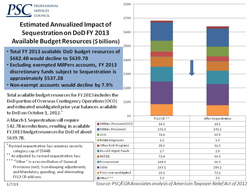
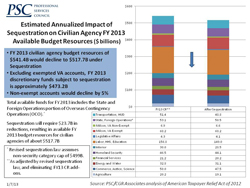
This law now requires the president to order a sequestration on March 1, 2013, with the potential for an additional sequestration action to be “evaluated and implemented” on March 27, 2013 if additional spending reductions are not achieved. Unless modified by a subsequent law, the discretionary spending savings required to be achieved through sequestration from March 1 through September 30, 2013 is $24 billion below the current level of discretionary spending reductions of $109.4 billion, providing a reduction to $85.4 billion, with approximately $42.7 billion coming from the “defense” category, $23.7 billion coming from the “non-defense discretionary” category, and $19 billion coming from certain non-defense mandatory spending programs.
According to PSC’s analysis of these changes, every Department of Defense “program, project and activity” would have to be reduced by 7.9 percent on an annualized basis to achieve the required savings. Similarly, every non-defense “program, project and activity” would have to be reduced by 5 percent on an annualized basis to achieve the required savings.
This law also extends into fiscal year 2014 the “firewall” between security and non-security discretionary spending that was due to phase out after fiscal year 2013. It also further reduces the overall discretionary spending in fiscal year 2014 by $8 billion, from $1.066 trillion to $1.058 trillion, with security discretionary spending capped at $552 billion and non-security discretionary spending capped at $506 billion.
12/27/12 - Debt Ceiling Limit will be Reached on December 31
On December 26, Treasury Secretary Geithner
notified Congress that the U.S. Government will reach the statutory debt ceiling by December 31, 2012, although actions Treasury will take will extend the government’s borrowing authority for several weeks. This action reinforces PSC’s view that the combination of the expiration of the Continuing Resolution on March 27, 2013, coupled with the actions necessary to address the debt ceiling, will provide the most critical time frame for addressing both short-term and long-term solutions to the fiscal issues facing the federal government.
12/20/12 - OMB Previews Sequestration Impact on Risk of Federal Employee Furloughs
According to Government Executive, today OMB Comptroller Danny Werfel distributed to federal agencies a sample set of talking points providing information that could be shared with federal employees about the impact of any imminent triggering of sequestration on agency operations on January 2, 2013, including addressing the possibility of furloughs for federal employees. Consistent with the guidance PSC has been providing to our member companies, OMB’s talking points confirm that “These cuts would not necessarily require immediate reductions in spending. Under sequestration, we would still have funds available after January 2, but our overall funding for the remainder of the year would be reduced ... For these reasons, I do not expect our day-to-day operations to change dramatically on or immediately after January 2, should sequestration occur. This means that we will not be executing any immediate personnel actions, such as furloughs, on that date.” PSC will continue to keep you informed of actionable information as it becomes available.
Following the OMB guidance, the following agencies issued their department-specific memos:
- Agriculture Department: Issued a December 20 memo that there would be no immediate furloughs on Jan. 2, 2013.
- Defense Departments: Issued a December 20 memo noting there would not necessarily be immediate action on Jan. 2, 2013.
- Interior Department: Issued a December 20 memo saying there would be no immediate personnel actions, such as furloughs.
- NASA: NASA Administrator Charles F. Bolden Jr. issued a December 20 memo saying NASA would still have funds available after January 2, but its overall funding for the remainder of the year would be reduced,"
11/26/12 - OMB Reports on FY 12 Unobligated Balances
On November 21, the Office of Management and Budget published a report on the balances of budget authority available for federal agencies at the end of fiscal year 2012. Included in this report is the amount of unobligated balances (budget authority that has not yet been committed by contract or other legally binding action) carried forward from fiscal year 2012 and thus available to each federal agency. Page 8 of the report identifies that DoD will have $78.398 billion in unobligated balances available for obligation as of the start of fiscal year 2013 and that International Assistance Programs will have $44.973 billion available. These amounts are fully consistent with PSC’s earlier estimates of these amounts and reflected in the PSC charts reflecting the impact of sequestration. As a reminder, under the 2011 Budget Control Act, in calculating the amount of “budget resources” that are subject to sequestration, if triggered, DoD must include the unobligated balances available to it in their calculation of the total budget resources; civilian agencies do not take such amounts into account. The full OMB report is available here.
Sequestration FAQ
- Companies are wondering how to plan for 2013. Is there anything we can do now?
- In the PSC July 10 sequestration program we identified a number of actions companies can begin to take now to better prepare themselves for sequestration. At right is a short video of simple tips to prepare your company and your government customers for the possible impacts in 2013.
- PSC has estimated budget cuts of ~10% in FY13 for DoD and ~8% for civilian budgets. Are those estimates still valid? If not, what has changed and what is the anticipated impact?
- Also, when issuing the contract changes on 1/2/13 will the customer have to negotiate the rate, price, milestone, requirements, etc changes prior to implementation or can the negotiation take place post the implementation? The way I see it, the customer can direct the contractor as to the change and any legal negotiations could happen post the implementation similar to how contractors frequently take work on undefinitized UCA contracts.
- At the PSC Sequestration Meeting this summer, it was indicated that the DoD O&M account was the lowest level of impact. Is this still the case? The implication then is that below the O&M line, there could be a lot of discretion which broadens the potential uncertainty for services firms yet also potentially creates opportunities. On the other hand, without specific OMB guidance, there is much uncertainty.
- What is sequestration's projected impact on USAID?
- In your sequestration presentation you mentioned that the sequester implementation will not be the same as under OMB guidance for a CR shutdown. Why is that?
- Given the fourth quarter of 2012 focus on sequestration, is it likely that procurements will decrease in the first quarter of 2013?
10/11/12 Update
On September 25, Deputy Secretary of Defense Ash Carter sent a memo to DoD officials cautioning them to “continue normal spending and operations” and to not take any action during the first quarter of fiscal year 2013 in anticipation of or for planning for sequestration. We’ve dubbed this memo the “business as usual” memo.
The deputy secretary directed all commanders “not to alarm our employees and their families by announcing personnel actions related to sequestration or by suggesting that these actions are likely." Despite the memo, we are aware of a few examples where DoD activities are deferring decisions to present options for sequestration. DoD has asked PSC to notify them if we become aware of any departmental action, or the failure to take action, that is tied in any way to sequestration.
On September 28, two organizations within the Office of Management and Budget issued a memo to federal chief financial officers and senior procurement executives providing guidance on when costs incurred in complying with the federal WARN Act would be allowable.
The memo provides that if (1) sequestration occurs and an agency terminates or modifies a contract that necessitates that the contractor order a plant closing or mass layoff “of a type subject to WARN Act requirements,”
and (2) the contractor has followed a course of action consistent with Department of Labor guidance [see below for that 7/30/12 Department of Labor guidance], any resulting employee compensation costs for WARN Act liability, including litigation costs, would be allowable costs and be covered by the contracting agency, if otherwise reasonable and allocable.
However, the memo also cautions that this guidance does not alter existing rights, responsibilities, obligations or limitations under individual contract provisions or the FAR cost principles. As such, companies should carefully review their existing contracts for (the unlikely event that there are) specific terms and conditions governing worker notifications and evaluate the applicability of the FAR cost principles (particularly relating to litigation expenses, fines and penalties, and employee salary reimbursements).
In early October, several Republican members of Congress reacted strongly to the OMB September 28 memo, accusing OMB of “playing politics” with contractor obligations for compliance with the WARN Act.
Some members, such as
Senators Grassley (R-Iowa) and Ayotte (R-N.H.) and House Education and Workforce Committee
Chairman John Kline (R-MI) asked OMB for detailed information and justifications forming the basis for the OMB statements on cost allowability and recovery.
Senator Graham (R-S.C.) asked DoD to notify him if contractor requests for reimbursement are received and threatened to ensure that “not one cent of taxpayer funds” would be paid in allowable costs to contractors that failed to comply with the requirement for sixty day advance notification to employees under the federal law. To date, not surprisingly, OMB has not responded to these demands for information.
9/18/12 Update
9/14/12 OMB Issues Preliminary Sequestration Report
On September 14, the Office of Management and Budget sent to Congress a 400-page report in response to the requirements of the
Sequestration Transparency Act of 2012 (P.L. 112-155) that the president signed on August 8. OMB acknowledged that the report provides “only preliminary estimates of the sequestration’s impact on more than 1,200 budget accounts.” In addition, the report did not identify any “programs, projects and activities”—the key phrase used in the Budget Control Act for determining the account level at which reductions will be required to be made under sequestration—because OMB admitted it needed more time to identify and resolve issues relating to such program, project and activity levels. Additionally, OMB calculated the percentage reductions based on the fiscal year 2012 enacted levels of appropriations, even though Congress will pass, and the president will shortly sign, a “continuing resolution” that established spending levels for the first six months of federal fiscal year 2013 (from October 1, 2012 through March 27, 2013) at the levels established for fiscal year 2013 in the Budget Control Act (see below). Based on their assumptions in the report, OMB estimates that there would be a sequestration of 9.4 percent for defense discretionary appropriations and 8.2 percent for non-defense discretionary appropriations.
9/13/12 House Adopts First Fiscal Year 2013 Continuing Resolution
On September 13, the
House approved the first continuing resolution (CR) providing appropriations for the federal government for fiscal year 2013 from October 1, 2012 through March 27, 2013. This six-month CR establishes overall funding levels for the federal government at the same level provided for fiscal year 2013 in the Budget Control Act. The CR also sets the level for the Overseas Contingency Operations (OCO) accounts at $99.9 billion—$88.5 billion for the Defense Department and $11.4 billion for the State Department and other civilian agencies. In addition, the CR includes special provisions relating to specific federal activities. The measure now goes to the Senate, which is expected to approve the bill during the week of September 17. The president is expected to sign the bill after final congressional action.
9/18/12 PSC Recalculates Sequestration Impact
Based on the House passage of the first continuing resolution (CR) for fiscal year 2013 (discussed above), PSC has recalculated the estimated annualized effect of sequestration on both the Defense Department and civilian agencies if sequestration happens on January 2, 2013. For DoD, at the major account levels, PSC estimates that the reduction in each “program, project and activity” will be 10.1 percent. For the civilian agencies, at the appropriations act level, the reduction would be 8.2 percent. Those charts are provided below. Because PSC’s estimates are based on the House-passed CR and OCO levels for fiscal year 2013, they differ from OMB’s estimates, which are based on enacted, fiscal year 2012 levels.
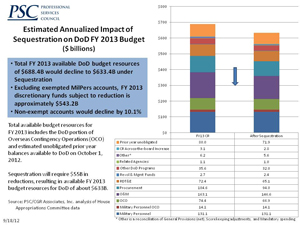
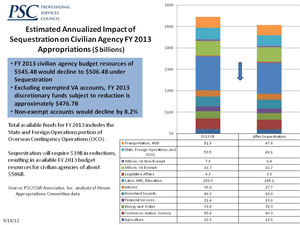
8/28/12 Update
OMB Provides Sequestration Update
Under the Budget Control Act (BCA), there are two distinct types of sequestrations. The first, and most commonly discussed, is the automatic, across-the-board sequestration that will take effect on January 2, 2013 unless Congress and the president take action to change the law. The second relates to the enforcement of caps on discretionary spending that are set out in the BCA if Congress passes and the president signs appropriations bills that exceed those caps; exceeding those limits would result in the president ordering a sequestration of discretionary budget authority. OMB is required to report on August 20 of each year on the status of appropriations acts against those limits. In its August 20, 2012 report, OMB notes that no appropriations bills have been enacted as of August 20 for fiscal year 2013 and a Continuing Resolution (CR) will be required, but that both the president and Congress are committed to working together to ensure that “an unintended discretionary sequestration” does not occur as a result of the CR. As a result, OMB does not anticipate a sequestration based on the BCA budget caps to be required at this time.
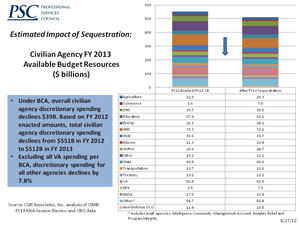 PSC Estimates Sequestration Impact on Civilian Agencies
PSC Estimates Sequestration Impact on Civilian Agencies
Since the Congress and the president have agreed to start fiscal year 2013 funding with a six month CR, the fiscal year 2012 enacted levels will likely serve as the basis for determining the application of the sequestration reductions to each federal agency if it takes effect on January 2, 2013. PSC has prepared a chart that shows our best estimate of the effect of sequestration on the top line funding for the major civilian agencies under a CR, based on the fiscal year 2012 enacted levels. It is important to note that the BCA exempts all Dept. of Veterans Affairs programs but we have excluded the VA entirely from our sequestration calculation, even though some VA civilian agency personnel and other VA spending could be subject to sequestration. Earlier this month, we provided PSC’s analysis of the estimated impact of sequestration on the major accounts in the Department of Defense.
8/7/12
As expected, the president signed the "Sequestration Transparency Act of 2012." Under the act, the president must send Congress, within 30 days after enactment, a detailed report about the sequestration process’ effects on spending, including specific information about the accounts to be reduced, the percentage reduction to be taken in each account, and an identification of all exempt accounts. That report is due on or before September 8, 2012. The law requires OMB to provide Congress with a report related to the spending reductions scheduled to take place under the terms of the Budget Control Act (BCA). The report is to include information about programs, projects, and activities (PPAs) that would be reduced under current law to achieve specified levels in the BCA. The report must also include an identification of all exempt discretionary accounts and direct spending accounts, and any other data and explanation of the sequester. The contents of this report must include, for discretionary spending, sequestration percentages and amounts necessary to achieve the required reduction of budgetary resources and the resulting reductions at the PPA level. Those percentages must be calculated relative to any enacted regular appropriation bills for fiscal year 2013. For spending that has not been funded through regular appropriation bills but rather through a Continuing Resolution (CR), the levels must be identified at a rate of operations as provided in appropriation Acts for fiscal year 2012. [Note, since the Congress and the president have agreed to start fiscal year 2013 funding with a six month CR, the fiscal year 2012 enacted levels will serve as the basis for determining the application of the sequestration reductions to each federal agency.] PSC has prepared a chart which shows our best estimate of the effect of sequestration on DoD accounts under a CR based on the fiscal year 2012 enacted levels. Chart: Estimated Impact of Sequestration on DoD Available Budget Resources
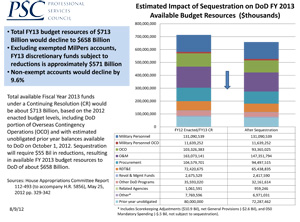 8/3/12
8/3/12
PSC president Stan Soloway sent a letter to DoD Undersecretaries Bob Hale (Comptroller) and Frank Kendall (AT&L) insisting that any sequestration guidance make clear that any decision to change the source of performance of work from the private sector to government employees must follow statutory requirements and be underpinned by rigorous cost analyses. PSC noted that we are aware of a number of informal comments, including from senior OSD officials, suggesting that one way the department could implement sequestration would be to insource currently contracted work on the faulty assumption that doing so will “save money.” Given the evidence amassed through the department’s most recent insourcing initiatives and elsewhere, PSC asserted that it is clear that such an assumption is not supported by the facts. Thus, PSC urged the department to require components, before any insourcing decision is made, to take specific action, including assessing the relative costs of public vs. private performance based on a truly complete comparison. We will monitor all of the agencies’ sequestration implementation to be alert for the use of insourcing to achieve spending reductions.
8/2/12
The Senate Appropriations Committee filed the bill and report on its recommendations for spending for DoD and related activities for fiscal year 2013. The committee included important guidance to the department on how to interpret and apply any sequestration requirement. The committee report provides the following important definition of the term “program, project or activity:”
"In fiscal year 2013, for purposes of the Balanced Budget and Emergency Deficit Control Act of 1985 (Public Law 99-177), as amended, the term 'program, project and activity' for appropriations contained in this act shall be defined as the most specific level of budget items identified in the Department of Defense Appropriations Act, 2013 and the P-1 and R-1 budget justification documents as subsequently modified by congressional action. The following exception to the above definition shall apply: for the military personnel and operation and maintenance accounts the term 'program, project and activity' is defined as the appropriations accounts contained in the Department of Defense Appropriations Act." (S.Rept. 112-196, pp. 8-9). No similar language was included in the House-passed version of the fiscal year 2013 Defense Appropriations Act.
This language is consistent with the interpretation that Deputy Secretary Carter discussed at the August 1 HASC hearing and with PSC’s understanding of DoD’s account structure. However, given the contemporaneous decision to enact a continuing resolution (CR) for the first six months of fiscal year 2013, it will be essential that this language be included in the CR or specifically referenced in the CR to have the intended effect.
8/1/12
Acting OMB Director Jeff Zients and Deputy Secretary of Defense Ash Carter testified before the House Armed Services Committee on the impact of sequestration. Although it became a contentious hearing, the Zients and Carter prepared statements added additional information on the process that OMB and DoD will follow to prepare for and implement any required sequestration requirement. Director Zients indicated that OMB had already asked federal agency general counsels for information on how they interpreted the application of the BCA sequestration requirements to their specific agency programs and activities. We will watch for any of those letters that become publicly available. In addition, Deputy Secretary Carter noted that DoD has interpreted the sequestration term “program, project and activity” to mean more than 2500 individual line items below the department’s “procurement” accounts but that there are no “PPA” levels below the account level for the operations and maintenance (O&M) or overseas (OCO) accounts.
7/31/12
The congressional leadership and the president announced an agreement to fund the government’s operations for the first six months of fiscal year 2013 through a Continuing Resolution. This appropriations act will be considered by Congress in September and must be signed into law before October 1, the start of fiscal year 2013. Senate Majority Leader Reid indicated that the CR would contain no policy riders and would be prorated at the 2013 spending level of $1.047 trillion that was set by the August 2011 Budget Control Act. The use of the phrase “prorated at 2013 spending levels” adds an element of confusion as to exactly what funding levels will be provided. Typically, a CR uses the rate of spending in prior year enacted appropriations, with such adjustments (“anomalies”) that necessarily must be included in CRs to adjust for unusual circumstances resulting from the use of prior-year levels, as requested by the agencies and agreed to by Congress. Because the specifics of this CR are still to be prepared, critical information is lacking, including information on any “anomalies.” Such adjustments would likely not have a significant effect on the overall percentage reduction under sequestration but could affect how that reduction is applied to specific agencies and programs. We’ll keep you informed as information becomes available.
Also on 7/31, OMB notified Congress that the president will use the authority under the Budget Control Act (BCA) to exempt military personnel accounts from sequestration. The BCA grants the president authority to exempt some or all of the military pay accounts in the Department of Defense. In a July 31 letter, OMB Acting Director Zients notified congressional leaders that the president intends to fully exempt military personnel accounts from sequestration. By fully exempting military pay from sequestration, the balance of the DoD accounts will be subject to a greater percentage reduction to achieve the mandatory reductions required by the BCA.
7/30/12
The Department of Labor issued a notice to state employment agencies providing important clarifications regarding the requirements of the federal Worker Adjustment and Retraining Notification (WARN) Act that might be applicable if sequestration happens. This guidance is consistent with the information and interpretations that PSC provided during the July 10 program. Many federal agencies are transmitting this Department of Labor guidance to their contractors and it will be posted in full on the FedBizOpps website. However, as a reminder, there may be additional notification responsibilities imposed on companies by state laws where employees work or under binding collective bargaining agreements. This DoL notice does not address those provisions.
Chvotkin and Soloway Discuss Simple Tips to Prepare for Sequestration
July 10, 2012 Program Audio:
Sequestration Presentation Slides:
Sequestration Reference Materials: